
You need Adobe Reader 7.0 or later in order to read PDF files on this site.
If Adobe Reader is not installed on your computer, click the button below and go to the download site.

|
Selected Papers: Wide Area Ubiquitous Network
Vol. 6, No. 3, pp. 14–20, Mar. 2008. https://doi.org/10.53829/ntr200803sp2
Wide Area Ubiquitous Network Service System
Hideki Toshinaga†, Koki Mitani, Hiroshi Shibata, Koichi Takasugi,
Mika Ishizuka, Satoshi Kotabe, Shinya Ishihara, Hiroshi Tohjo, and Hiroshi Saito
Abstract
The core network of NTT's wide area ubiquitous network (WAUN) should be designed considering scalability and support for low-performance terminals because the infrastructure of the ubiquitous society must economically handle an extremely large number of mobile low-power-consumption terminals distributed over a very wide area. In this paper, we describe the structure of the function distribution and a protocol suitable for WAUN.
| † |
NTT Network Innovation Laboratories
Musashino-shi, 180-8585 Japan
 |
1. Introduction
NTT has proposed the wide area ubiquitous network (WAUN) as a new wireless network for building a ubiquitous society [1]–[3]. WAUN is an infrastructure for ubiquitously networked small computers, including sensors and actuators, that enables us to be networked anywhere and anytime with anybody and anything and enjoy a convenient life. There are some conventional approaches to building such a network for the ubiquitous society by, for example, extending existing networks such as the optical access network or the mobile telephone network by using ad-hoc network technology. However, ad-hoc networks were intended for building local area networks, so this technology is insufficient for building a ubiquitous network as an infrastructure that anyone can use. The infrastructure of the ubiquitous society must economically accommodate an extremely large number of terminals, for example microminiature sensors and actuators, which feature mobility, low performance, and low electricity consumption, distributed over a very wide area. WAUN requires a protocol for the wireless interface that is suitable for low-performance low-power-consumption terminals similar to RF-ID (radio frequency identification) tags that run on batteries. Its cell radius will be a few kilometers in order to accommodate many terminals, far more than the existing number of personal computers and cellular phones in each cell.
To make WAUN a reality, the WAUN core network must be designed considering scalability and support for low-performance terminals. For scalability, the WAUN core network will utilize function distribution, which is regarded as a characteristic of WAUN for achieving scalability. In addition, WAUN will use a simpler protocol than conventional cellular phone networks and IP (Internet protocol) networks and use an architecture in which the core network performs most of the functions currently performed by the terminals.
This paper describes the WAUN core network architecture that NTT is designing.
2. System configuration
The composition of WAUN is shown in Fig. 1. The WAUN core network consists of access points (APs), a management database (MDB), radio access network servers (RANSs), and IP gateways (IP-GWs).
- MDB: The MDB stores profile information about user stations (USs) for authentication, authorization, and accounting. It also stores US location information.
- RANS: A RANS controls location registration and authorizes a US to upload data.
- IP-GW: An IP-GW counts traffic for accounting purposes and authorizes a wired terminal to download data.
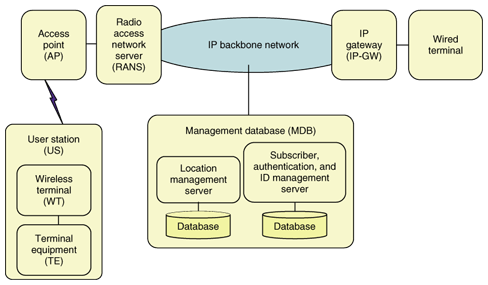
Fig. 1. Wide area ubiquitous network (WAUN).
An AP has a wide coverage (several kilometers) and can accommodate a lot of USs, which consist of wireless terminals and terminal equipment (TE). TEs are, for example microminiature sensors and actuators. Wired terminals are IP terminals that communicate with wireless terminals in WAUN and are accommodated through an IP-GW. A wired terminal receives data acquired by a TE and transmits commands to the TE. WAUN works as a middle box between a wireless terminal and a wired terminal. It provides a data upload service from the TE to the wired terminal and a data download service from the wired terminal to the TE.
A RANS works as a server to control the US (providing authentication, authorization, and location management). A US connects to different RANSs depending on its location. In contrast, an IP-GW always connects to the same wired terminal regardless of the location of the US. WAUN has an architecture for distributing the functions of the core network devices. When the radio accommodation design needs to be changed in response to a change in AP placement or an increase in the number of radio channels, etc., it is possible to change just the RANS settings and increase or reduce the number of RANSs. On the other hand, when there is a change in the use of a wired terminal, it is possible to change just the settings of the IP-GW and increase or reduce the number of IP-GWs. The WAUN architecture has sufficient flexibility to handle scalability requirements.
3. Protocol
WAUN will accommodate a large number of USs and receive a small amount of data in a limited radio frequency band. These characteristics require the communication overhead to be small and communication opportunities to be obtained fairly by USs. The WAUN protocol should be designed considering these needs.
3.1 Protocol features
The structure of the protocol for WAUN is shown in Fig. 2. Two representative characteristics of the transmission protocol are described below.
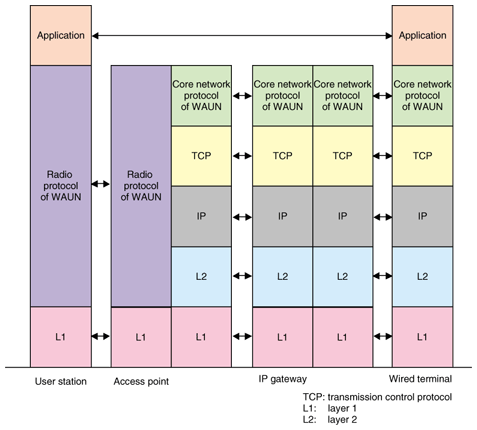
Fig. 2. Structure of WAUN.
1) WAUN core network controls communication between a US and wired terminal
In an IP network, a terminal itself decides when to transmit a message. A terminal makes a packet with a suitable header that includes the destination IP address, and the network carries the packet and delivers it to the destination terminal by routing based on the destination IP address. In contrast, WAUN uses a protocol in which the core network decides the destination terminal when a US sends data. There are three reasons for doing this.
- A US should be able to communicate with an authorized wired terminal and not have to communicate with an unspecified number of wired terminals. There are growing concerns about the security of communicating with unspecified wired terminals.
- It is not necessary to transmit the destination address (when a US sends a packet to a wired terminal) or the source address (when a wired terminal sends a packet to a US). This makes it possible to use the transmission channel effectively. For example, the address has 128 bits in IPv6. In WAUN, where many terminals share a limited band, this would have a very large impact.
- It is possible to change the destination wired terminal without changing the settings of the US. When we assume that low-performance sensors are scattered in various places as USs, it is very important that the only settings to change are those in the WAUN core network.
2) WAUN uses several identifiers (IDs) for a US, and an ID sent over a radio link is assigned temporarily and often updated
WAUN uses different IDs on the radio links and in the wired network. The ID to use in the wired network is assigned in a fixed manner independent of the location of the US and it is long enough that a US can be distinguished uniquely while it is using a WAUN service. The ID to use on the radio link is temporary and often updated, and it is long enough to distinguish each US uniquely in the current WAUN. This is done because a US should be prevented from performing tracking for a stranger and because it enables transmission channels to be used effectively.
3.2 Basic protocols
This section describes some representative basic protocols (location registration, upload from a US to a wired terminal, and download from a wired terminal to a US). In WAUN, two kinds of data communication sequences are prescribed: the download sequence from a wired terminal to a US and the upload sequence from a US to a wired terminal. On the other hand, WAUN does not prescribe direct communication between two USs because a US has insufficient ability to judge a destination address by itself or to change it.
1) Location registration protocol
This prescribes two kinds of location registration protocols (Fig. 3): the protocols for when a US moves to a different AP accommodated by the same RANS and moves to a different RANS. In WAUN, the MDB stores master profile information about all USs. This information is used for security and for authentication, authorization and accounting (AAA). When a RANS receives a location register request from a US and the RANS has no profile information for the US concerned, it acquires the information from the MDB. After that, the local RANS controls the location management without reacquiring it from the MDB. Using two kinds of location registration protocols should reduce the load on the MDB and shorten the time needed for communication.

Fig. 3. Location registration protocol.
2) Upload/download protocols
The protocols for uploading data from a US to a wired terminal and downloading data from a wired terminal to a US are shown in Figs. 4 and 5, respectively.
- WAUN should limit the number of possible communication opportunities that each US has to ensure fairness among USs. To achieve this, WAUN uses an authorization procedure before every data transmission. RANS performs authorization at upload, and the IP-GW performs it at download.
- WAUN uses a four-way sequence between a wired terminal and an IP-GW for the download protocol. An “Acceptance notice” message indicates that the WAUN core network has authorized the transmission and started the procedure for transmitting data. A “Data reply” message indicates that the US has received the data. The authorization procedure in the IP-GW should help ensure fair communication opportunities among USs. In addition, it may be used to restrict traffic at times when the WAUN is congested.
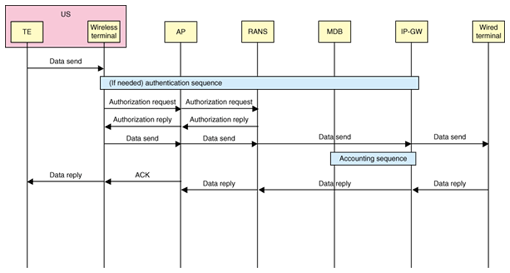
Fig. 4. Upload protocol.
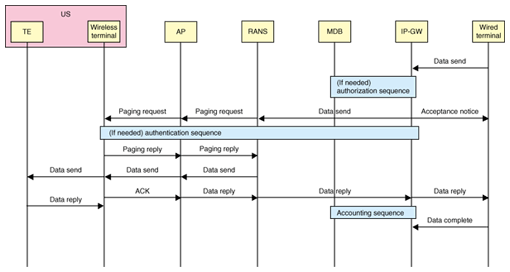
Fig. 5. Download protocol.
4. Conclusion
This paper introduced the core network architecture of the WAUN that NTT has proposed as a new infrastructure for building a ubiquitous society. We described the structure of the function distribution and a protocol suitable for WAUN, which can economically handle an extremely large number of mobile low-power-consumption terminals distributed over a very wide area. We will prove the feasibility of WAUN through a field trial in future.
References
| [1] |
H. Saito, M. Umehira, and M. Morikura, “Considerations of Global Ubiquitous Network Infrastructure,” IEICE Trans., Vol. J88-B, No. 11, pp. 2128–2136, 2005 (in Japanese). |
| [2] |
H. Saito, M. Umehira, and T. Ito, “Proposal of the wide area ubiquitous network,” World Telecommunication Congress, Budapest, Apr. 2006. |
| [3] |
H. Saito and K. Takasugi, “Recent Developments in Wide Area Ubiquitous Network Research,” ISADS, pp. 503–507, Sedona, AZ, Mar. 2007. |
 |
- Hideki Toshinaga
- Research Engineer, Ubiquitous Network
Systems Laboratory, NTT Network Innovation Laboratories.
He received the B.E. and M.E. degrees from the Department of Electronics and Communications of Waseda University, Tokyo, in 1994 and 1996, respectively. He joined NTT Wireless Systems Laboratories in 1996. He is currently working on the protocols and architecture of wide area ubiquitous networks. He is a member of the Institute of Electronics, Information and Communication Engineers (IEICE) of Japan.
|
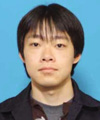 |
- Koki Mitani
- Ubiquitous Network Systems Laboratory,
NTT Network Innovation Laboratories.
He received the B.S. and M.S. degrees in
information and computer science from Keio University, Kanagawa, in 2003 and 2005,
respectively. He joined NTT Network Innova
tion Laboratories in 2005. He is currently working on the protocols and architectures of wide area ubiquitous networks. He is a member of IEICE.
|
 |
- Hiroshi Shibata
- Ubiquitous Network Systems Laboratory,
NTT Network Innovation Laboratories.
He received the B.E. degree in electronic engineering and M.E. degree in electrical engineering from Osaka University, Osaka, in 1994 and 1996, respectively. He joined NTT Network Service Systems Laboratories in 1996. He has mainly been working on distributed object-oriented systems, information providing systems, P2P networks, and sensor network systems.
He is currently evaluating and improving the scalability and quality of wide area ubiquitous network products.
|
 |
- Koichi Takasugi
- Research Engineer, Ubiquitous Network
Systems Laboratory, NTT Network Innovation Laboratories.
He received the B.E. degree in computer science from Tokyo Institute of Technology, Tokyo, the M.E. degree in information science from Japan Advanced Institute of Science and Technology, Ishikawa, and the Dr.Eng. degree from Waseda University, Kitakyushu, in 1995, 1997, and 2004, respectively. He joined NTT Wireless Systems Laboratories in 1997. He has mainly been working on mobile ad-hoc networks, P2P networks, and RFID systems. He is currently working on the protocols and architectures of wide area ubiquitous networks. He is a member of IEICE and the Information Processing Soci-ety of Japan.
|
 |
- Mika Ishizuka
- Research Engineer, Ubiquitous Network
Systems Laboratory, NTT Network Innovation Laboratories.
She received the B.E. and M.E. degrees in control engineering from Keio University, Tokyo, in 1992 and 1994, respectively. She joined NTT in 1994 and has been engaged in research on traffic control in communication systems. She is currently engaged in research on wide area ubiquitous networks. She received the IEICE Information Network Research Award in 2003. She is a member of IEICE and the Operations Research Society of Japan (ORSJ).
|
 |
- Satoshi Kotabe
- Senior Research Engineer, Ubiquitous Network Systems Laboratory, NTT Network Innovation Laboratories.
He received the B.E. and M.E. degrees in
electronic engineering from Ibaraki University, Ibaraki, in 1993 and 1995, respectively. He joined NTT in 1995. He has mainly been working on high-speed data communication network architectures. His current research includes the protocols and architectures of wide area ubiq-uitous networks. He is a member of IEEE and IEICE.
|
 |
- Shinya Ishihara
- Senior Research Engineer, NTT Network Innovation Laboratories, Manager of NTT R&D Produce Group Research and Development Planning Department.
He received the M.E. degree from Osaka University, Osaka, in 1994. He joined NTT LSI Laboratories in 1994 and worked on LSI CAD systems. He is currently involved in research on wide area ubiquitous networks. He is a member of IEICE.
|
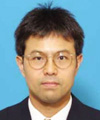 |
- Hiroshi Tohjo
- Senior Research Engineer, Supervisor, and Group Leader of NTT Network Innovation
Laboratories and Senior Manager of NTT R&D Produce Group Research and Development
Planning Department.
He received the B.S. and M.S. degrees in electronics engineering from Nagaoka University of Technology, Niigata, and a Ph.D. degree from Osaka University, Osaka, in 1989, 1991, and 1999, respectively. He joined NTT Transmission Systems Laboratories in 1991. His current research interests include wide area ubiquitous network systems and service systems. He is a member of IEICE.
|
 |
- Hiroshi Saito
- Executive Manager, Ubiquitous Service
System Laboratory, NTT Network Innovation Laboratories.
He received the B.E. degree in mathematical engineering, the M.E. degree in control
engineering, and the Dr.Eng. degree in teletraffic engineering from the University of Tokyo, Tokyo, in 1981, 1983, and 1992, respectively.
He joined Nippon Telegraph and Telephone Public Corporation (now NTT) in 1983. He received the Young Engineer Award from IEICE in 1990, the Telecommunication Advancement Institute Award in 1995, and the Excellent Papers Award from ORSJ in 1998. He is a fellow of IEEE, IEICE, and ORSJ, and a member of IFIP WG 7.3.
|
↑ TOP
|























